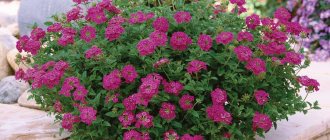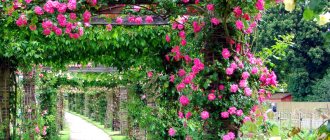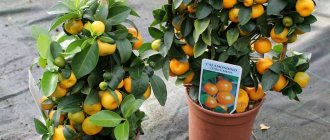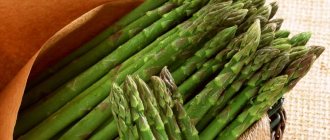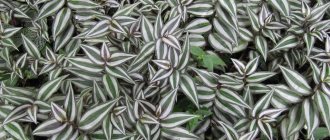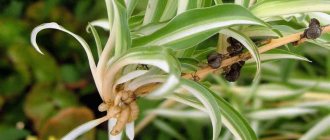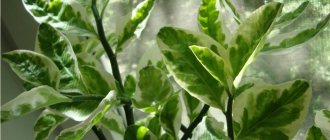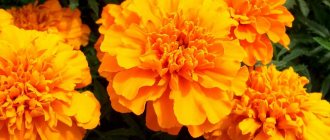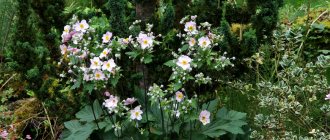Wanting to make their plot beautiful, every owner strives to choose plants that will ultimately create a harmonious composition. Rowan-leafed mountain ash will be an excellent way to decorate your home area. The bush does not require complex care and takes root in any garden plot.
Just like rowan
Botanical certificate
Rowan-leafed fieldfare is readily used in landscape design by both professionals and amateurs. The plant got its name due to the obvious similarity in the shape of the leaves with the well-known mountain ash. Deciduous shrubs can be described by the following parameters:
- In adulthood, the bush reaches a height of 2-3 m with a crown diameter of up to 2 m.
- The plant is unpretentious, fast-growing, with a lush spreading crown.
- The bush is formed by many erect shoots up to 1.5 cm thick.
- The leaves reach 15-28 cm in length, consist of 12-23 leaflets of a more elongated and pointed shape than those of mountain ash.
- The flowers are white, with a slight yellow tint, medium-sized (10-12 mm), and have a pleasant aroma. The flowers are collected in inflorescences-panicles of a pyramidal shape, 25 cm in length. Each flower has long stamens with anthers, which is why the inflorescences look fluffy.
- Flowering lasts in June-July, the fruit is polyspermous.
Fieldfare inflorescence
Features and benefits
The shrub, which belongs to the Rosaceae family, has a number of features that must be taken into account when purchasing a seedling; significant ones include:
- Frost resistance. The plant can withstand frosts down to -30°C. In the frosty winter conditions of the northwestern region, protection is required in open ground - covering with spruce branches.
- The growing season begins in early spring.
- Field ash grows well in moist and infertile (sandy) soils. Although the adult plant is considered light-loving, it also grows well in partial shade. The bush does not tolerate drought well, losing its decorative properties; in extreme heat it needs watering.
Fieldfare is a real gift for beginning amateur gardeners. The plant quickly sprouts and grows successfully not only in rural areas, but also in urban environments (annual growth is up to 10-12 cm). It tolerates replanting well and annual spring pruning carried out for sanitary and rejuvenating purposes.
Sapling of mountain ash
Although in nature fieldfare can also reproduce by seeds, it is quite difficult to grow it at home. A faster and more productive method of propagation is by cuttings (root or shoots). The plant is cultivated due to a number of positive qualities:
- Graceful feathery leaves and large inflorescences make the shrub suitable for decorative use.
- Abundant and long flowering make fieldfare a valuable honey plant.
- The plant contains many useful substances, including vitamins C, P, essential oil, and tannins. Preparations based on fieldfare have medicinal properties: antiseptic, antibacterial, antirheumatic. The shrub is widely used in folk medicine as an astringent, tonic and regulating metabolic processes.
- The shrub can be used to strengthen the soil on slopes and areas with sandy soil.
See also: Catalog of companies that specialize in designing and performing landscape work of any complexity
Decorative options
Kinds
Under natural conditions, various species of fieldfare are found in the temperate zone of Europe and Asia, including the islands of Japan and the Korean Peninsula. In the Russian Federation, the plant grows in the Far East, Siberia and the Southern Urals. Breeders have developed about ten varieties, which are successfully cultivated in Europe and North America; the most popular include:
- Pallas's Fieldfare. The maximum height of fieldfares in nature is 5-6 m, but those used for decorative purposes do not grow higher than 2.5-3 m. Among the latter, Pallas's fieldfare stands out for its particularly low growth: no more than 1.2 m, and more often - up to 0.8 m. Despite its small size, it has quite large flowers compared to other species. Although the bush is distinguished by its endurance, unpretentiousness and early ripening (blooms in the first or second year), it does not often decorate areas due to its fragility.
Bush during flowering
- Fieldfare tree (Kirillova). The tallest plant of all varieties, with a crown height reaching 5-6 m. The bush has a lush but neat appearance, and pleases with flowering from July to August. Valuable quality - high (up to -25°C) frost resistance.
- Felt. Tall (up to 6 m), with a wide crown, rarely blooming and poorly tolerant of frosty winters - the main reasons for the weak interest of gardeners.
Tree-shaped fieldfare
A favorite of garden and home plots is the fieldfare; In landscape design in Russia, two varieties are readily used:
- Stellifila. It tolerates harsh Russian winters well and boasts original leaves with a brownish edge.
- Sam (Sem). The ornamental shrub grows slowly, so it is ideal for forming a hedge. It is used for single and group plantings in clearings and the banks of reservoirs.
Variety Sam
How to care for ornamental shrubs
To protect bushes from grass, pests and diseases, it is necessary to apply the entire range of agrotechnical measures.
How to water a plant
Fieldfare loves water, young plants are watered every week with 1 bucket per bush, in hot weather they are watered 2 times a week. Shrubs that are 2-3 years old are watered every half month, in hot weather - every week. Drought at high air temperatures has a negative effect on the bush; it is sprayed generously with water early in the morning or in the evening, when the sun has already set, otherwise the leaves will get burned.
Weeding and loosening
Fieldfare has developed, but not deep roots, so it is loosened once a month very carefully and shallowly, preferably immediately after watering, then mulch is added to the ground near the trunk as needed. Weed as needed.
Feeding and fertilizer
In the first months of spring and summer, fieldfare is fertilized with organic fertilizers - this can be peat mixed with soil, lying manure or compost. Mineral fertilizers are applied according to the following scheme:
- urea, 40 g per square meter, applied in spring;
- potassium nitrate, 15 g per square meter - during flowering;
- superphosphate, 40 g per square meter, is applied in early autumn.
The solution is watered around the tree trunk.
Shrub pruning
In the spring, frozen and broken shoots, as well as branches bending towards the ground, are cut off from the plant, if it is not necessary to grow layering.
In addition to sanitary pruning, there is formative pruning, which is carried out in the third year of bush growth in the spring. The plant is given the desired shape, then the shoots are regularly trimmed until autumn, while flower stalks are formed on the growth.
If the crown is not thinned out, the bush thickets become too dense, and it begins to throw out thin, rapidly aging branches. When thinning the crown, above-ground root shoots are also removed.
Rejuvenating pruning is carried out when the branches begin to become bare at the bottom and dry out at the top. Such branches are completely removed. Once every few years, the bush is almost completely pruned, leaving stumps about 15 cm high. This pruning is done on well-rooted plants, in early spring, by autumn powerful shoots will form on the plant, the plant will be completely renewed.
Planting rules and care
To grow fieldfare, no special knowledge in gardening is needed. In order for the plant to take root well in open ground, follow the following rules:
- Timing. The shrub is planted in the fall, or with the arrival of spring, before the leaves begin to bloom.
- For each plant, a hole is dug 0.6-0.7 m wide and 0.5 m deep. The distance between holes is at least 1 m.
- The hole is prepared by covering the bottom with a layer of drainage material. A layer of soil with fertilizer (humus) is poured over the drainage. A seedling is placed on top, the roots are covered with earth.
- Although all types of fieldfare prefer moist soil, it is important to maintain water balance so that the plant does not get sick from excess water. 2 buckets of water are poured under each seedling and the ground is mulched.
Further care consists of timely watering of the bush with periodic loosening of the soil. Pruning to maintain shape is carried out once a year, in autumn or early spring. At the end of summer, when the fading inflorescences begin to spoil the appearance of the plant, they are removed.
Fieldfare bush in the landscape of the site
Reproduction of fieldfare
Most often, fieldfare is propagated in one of the following ways:
- cuttings;
- from layerings.
The easiest way to propagate fieldfare is by cuttings.
Cuttings
The description of propagation by cuttings does not involve particularly complex manipulations. Therefore, the method is used in practice more often than others. Cuttings are taken from strong woody stems. Their length should be 20-30 cm. For rooting, the cuttings are planted in a container with soil. Next, all that remains is to carefully ensure that the soil remains moist throughout the entire process of rooting the future shrub.
Important! You can understand that the rooting of the cuttings was successful by the beginning of the growth of the tops.
From layerings
Propagating fieldfare from layering is quite easy. To do this, in the spring, take a long and (necessarily!) completely healthy stem. It is carefully bent to the ground so that the buds are in contact with the ground. In this position, the stem is fixed by covering it a little with earth. It is very important that the top is on the surface. After a while, the cuttings will take root; at the end of summer, they will need to be cut off from the mother plant and replanted.
Fieldfare shrub does not create any particular problems in terms of planting and care. In order for the cultivation to be successful and the plant to begin to bloom, you need to follow some rules regarding watering, feeding and preparing the plant for winter.
Landscape design value
The main decorative value of fieldfare as a shrub in landscape design is its leaves, which change color depending on the time of year. Throughout the season, the crown looks picturesque. Young leaves have an orange-pink tint; by summer, during the flowering period, their color becomes light green, and in autumn - burgundy-orange. Young shoots appear throughout the summer and create the illusion of flowers.
Gardeners who want to decorate their home area are offered to use mountain ash in landscape design; What it goes with will be suggested by the following ideas:
- A bush as the main element of a garden composition, surrounded by flowers and herbaceous perennials.
- As part of a group planting in combination with another shrub (for example, lilac).
- As an element of a hedge and a replacement for expensive crops (cotoneaster, thuja).
- A bush planted next to a very tall tree will camouflage the trunk with its crown.
- Fieldfare in contrasting planting. White inflorescences look harmonious against the background of coniferous trees, as well as next to a wooden bench or large stones.
In landscape design
Annual plants as part of a flower border
Annual plants live a short but vibrant life. In early spring, their seeds are sown in order to obtain seedlings. In the summer they turn into blooming bouquets, and wither in the fall. Every year the border of annual flowers will have to be renewed. But this is the only drawback, and it is completely offset by the advantages of a border of annual flowers.
Such plants, even purchased as seedlings, are inexpensive and bloom very beautifully. Even in the very fact of their annual renewal there is a positive hidden: you can create new beautiful combinations of plants. Below we give you a small list of the best varieties.
Marigold. Among the many varieties of these plants, preference should be given to low-growing border flowers. Marigolds bloom from June until the coldest weather. There are varieties of marigolds with double and simple flowers. A little shade does not interfere with their growth and flowering. Marigold seedlings are planted in mid-May.
Marigolds never look too simple: the plants are varied, attractive and not boring: there are both simple and double varieties
Nasturtium. This plant loves warmth and light. Nasturtiums planted ahead of schedule may freeze. Nasturtium cannot tolerate replanting, so it needs to be grown in peat pots. If the plant doesn't get enough light, it may stop blooming and growing. Moderately fertile and moist soil is ideal for nasturtium.
Nasturtiums will decorate the area both as border flowers, and in hanging baskets, and even just in decorative pots placed along the path
Verbena
It is important not to make a mistake and choose a low-growing plant. Verbena seeds can already be planted in the ground in April if they are covered with film on top. This drought-resistant and light-loving plant does not tolerate excessive watering.
This drought-resistant and light-loving plant does not tolerate excessive watering.
Verbena can be in union with marigolds and marigolds, but for rudebeckia and helenium they create a sharp contrast
Ageratum. Among annuals, flowers with such an amazing blue color are very rare. In order for the seedlings of this plant to be healthy, they need to be planted towards the end of March or early April. Ageratum blooms in June and fades only by September.
It is important not to plant the plant in the shade and not to over-fertilize the soil, otherwise there will not be sufficient flowering; overgrown ageratum can be cut
Iberis. In March-April, the seeds of this plant can be sown in the ground. You just need to place them at a certain distance from each other, because when replanting the plant often suffers. Read more about planting and care.
Iberis is usually planted in borders along with tall annual flowers: it creates a wonderful snow-white background that makes the garden elegant
Lobelia. This plant loves the sun. Its pink or blue flowers bloom in June, and abundant flowering continues until frost. Seedlings of these plants should be placed under glass.
Look at these flowers and think if you would like to have this amazing royal blue color in your garden plot
Cineraria. Undemanding and unpretentious, cineraria look gorgeous, but are very sensitive to waterlogging. In the shade, the wonderful silver shade of the plant can turn into ash gray. The plant reproduces by seeds.
This magnificent plant looks a little like coral and, like coral at the bottom of the sea, has a strong attractive power
Alyssum. Alyssum sown in early spring directly into the soil under the film will bloom 1.5 months after germination. Loves cool weather and emits a delicate aroma that attracts butterflies and bees.
The delicate aroma of this plant can attract bees and butterflies to it, and the fragile vulnerability of flowers attracts people's attention
There simply isn't enough space to display the many annuals that make great borders.
Conclusion
This ornamental shrub is a profitable purchase for any site, capable of beautifying the area. Fieldfare is designed to be a bright accent in the garden, whether it grows in a group or graces the lawn alone. If you want the bush to delight with bright colors from early spring until the leaves fall, prune after flowering and then feed the plant.
A little more attention!
Do you think it’s worth betting on such an ornamental foliage plant? No matter how unpretentious it may be, part of the care is a rather labor-intensive process - pruning. In any case, it is necessary to remember about the active growth of the plant. To prevent young shoots from taking over the surrounding space, the shallow roots of the bush will have to be surrounded with a protective ring.
Transfer
When the mountain ash begins to interfere with other crops or has grown very large, it is transplanted to a new place. Transplantation is performed no more often than once every 3 years. During transplantation, the bush is immediately divided if necessary. This is how fieldfare can be propagated, for example, to create a hedge.
The process of transplanting and dividing an adult bush:
- A planting hole is dug in the area chosen for the plant. Its depth is at least 50 cm if the bush is young, and up to 70 cm for an adult bush. Diameter – up to 70 cm;
- At the bottom of the recess, you need to lay a layer of pebbles or pieces of brick of 6-7 cm for drainage;
- A soil mixture is prepared, consisting of leaf compost, humus, soil and a mineral complex for garden crops. All varieties of mountain ash can be replanted and divided into small bushes;
- The bush is carefully dug out using a bayonet shovel. If you need to divide it into parts, then use a sharp knife to divide it into tubers. Each division should have buds and developed shoots;
- The cut site must be treated with crushed activated carbon or a root formation stimulator;
- Divided bushes are placed in new planting holes at a distance of 1 m;
- The holes with the divisions are sprinkled with soil mixture and watered abundantly. The root collar is not sprinkled; it must be above the ground level.
After the water is absorbed, add soil if necessary and mulch.
